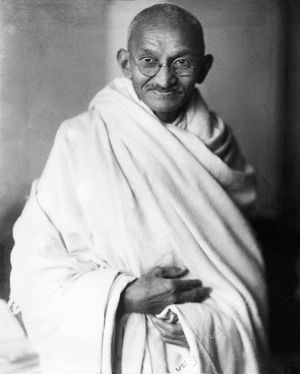Satyagraha

Satyagraha [Skt.]: pressure for social and political reform through cheerful nonviolent resistance practiced by Mohandas K. Gandhi and his followers. As he defined it:
Truth (satya) implies love, and firmness (agraha) engenders and therefore serves as a synonym for force ... that is to say, the force which is born of truth and love or nonviolence.[1]
Gandhi wrote:
The beauty of this method is that it comes up to oneself; one has not to go out in search for it.... God Himself plans the campaign and conducts battles. It can be waged only in the name of God.... Only when the combatant finds utter darkness all around him, only then God comes to the rescue.[2]
Gandhi knew that Jesus Christ had been called the original passive resister, but he saw him as the original Satyagrahi.
Critics of Gandhi call his philosophy masochistic because people sustained beatings without resisting in the Satyagraha campaigns. Yet how many more die in war without any sense of self-esteem, without having taken a stand for a moral principle or made the ultimate sacrifice for the cause of Truth. Satyagraha is the strategy of a mastermind who knew the enemy well yet held the salvation and soul integrity of his followers as paramount.
Although Gandhi was an advocate of nonviolence, he recognized that even a predominantly nonviolent state would need both a police force and an army. But those who served in the police or armed forces of the state should constitute a body of disciplined and loyal reformers who, among other things, subscribed to the creed of nonviolence.
While Gandhi believed in nonviolence, he thought cowardice was despicable. In his famous editorial “The Doctrine of the Sword” (Young India, August 11, 1920), he stated that when there was “only a choice between cowardice and violence,” he “would advise violence.” He also favored violence over appeasement which was cowardice in disguise. In fact, when it came to protecting innocent people from assault, Gandhi believed that for those not wholeheartedly committed to nonviolence, violence was a duty. This, of course, was not intended to be a loophole for terrorists, assassins, and anarchists.
Sources
Pearls of Wisdom, vol. 28, no. 24, June 16, 1985.
Heart magazine, Autumn 1983.
